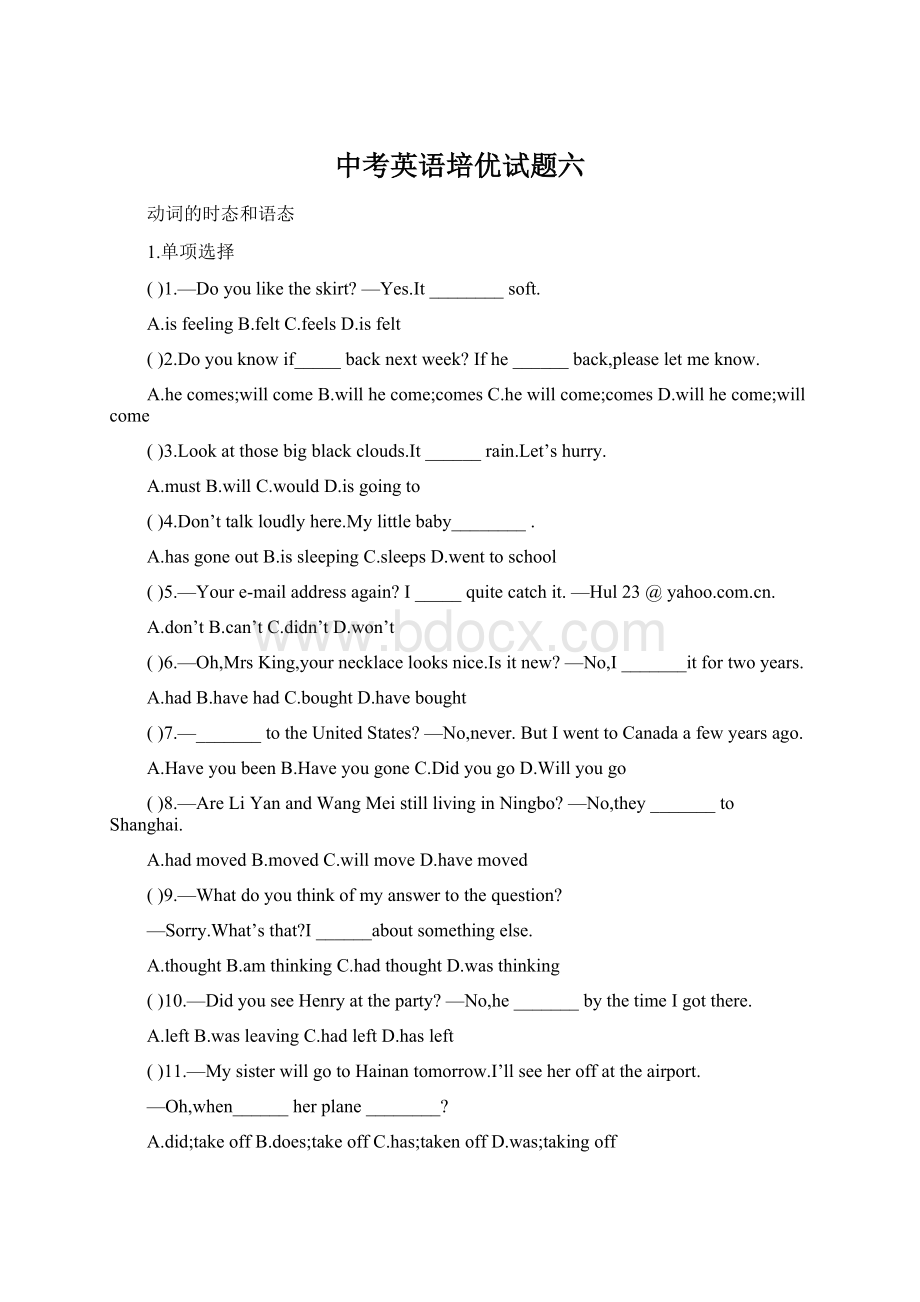中考英语培优试题六Word格式文档下载.docx
《中考英语培优试题六Word格式文档下载.docx》由会员分享,可在线阅读,更多相关《中考英语培优试题六Word格式文档下载.docx(18页珍藏版)》请在冰豆网上搜索。

I_____quitecatchit.—Hul23@.
A.don’tB.can’tC.didn’tD.won’t
()6.—Oh,MrsKing,yournecklacelooksnice.Isitnew?
—No,I_______itfortwoyears.
A.hadB.havehadC.boughtD.havebought
()7.—_______totheUnitedStates?
—No,never.ButIwenttoCanadaafewyearsago.
A.HaveyoubeenB.HaveyougoneC.DidyougoD.Willyougo
()8.—AreLiYanandWangMeistilllivinginNingbo?
—No,they_______toShanghai.
A.hadmovedB.movedC.willmoveD.havemoved
()9.—Whatdoyouthinkofmyanswertothequestion?
—Sorry.What’sthat?
I______aboutsomethingelse.
A.thoughtB.amthinkingC.hadthoughtD.wasthinking
()10.—DidyouseeHenryattheparty?
—No,he_______bythetimeIgotthere.
A.leftB.wasleavingC.hadleftD.hasleft
()11.—MysisterwillgotoHainantomorrow.I’llseeheroffattheairport.
—Oh,when______herplane________?
A.did;
takeoffB.does;
takeoffC.has;
takenoffD.was;
takingoff
()12.—Isawhersmokingintherestaurantyesterdayafternoon.—Butsheseldom_______.
A.smokesB.hadsmokedC.smokedD.issmoking
()13.IusedtolovethisfilmwhenIwasyoung,butI______itthatwayanymore.
A.don’tfeelB.didn’tfeelC.haven’tfeltD.hadn’tfelt
()14.—WasKatehappytoseeheroldfriendsyesterday?
—Yes,shewas.She____themforalongtime.
A.didn’tseeB.wouldn’tseeC.hasn’tseenD.hadn’tseen
()15.—Hasyourmotherfinishedherreport?
—Sorry,Idon’tknow.She______itthismorning.
A.iswritingB.wroteC.writesD.haswritten
()16.—Whendidthemeetingbegin?
—Atfouro’clock.It______for15minutes.
A.wasonB.beganC.hasbegunD.hasbeenon
()17.—Howwasyourdayoff?
—Prettygood!
I_____thesciencemuseumwithmyclassmates.
A.visitB.visitedC.amvisitingD.willvisit
()18.Boiledwater_______forfreehereinthedaytime.
A.offerB.offeredC.isofferingD.isoffered
()19.MrsJohnson’sfunnystory_____byeveryonewhoheardit.
A.laughedatB.waslaughedC.laughedD.waslaughedat
()20.Necessaryaction_______sothatstudentscanbesafeatschool.
A.canbetakenB.maybetakenC.mustbetakenD.mightbetaken
()21.—DidyougotoJim’sbirthdayparty?
—No,I_______.
A.amnotinvitedB.wasn’tinvitedC.haven’tinvitedD.didn’tinvite
()22.Pleasedon’tstandupinclassuntilyou______.
A.weretoldtoB.aretoldtoC.weretoldD.aretold
()23.—IsBohaiBridgeopentothepublicyet?
—Yes.It_______foralmostoneandahalfmonths.
A.hasopenedB.hasbeingopenedC.hasbeenopenD.wasopen
()24.Sofar,allthewalls______white,andwearegoingtodrawallkindsofpicturesonthem.
A.havebeenpaintedB.havepaintedC.arepaintedD.painted
()25.—CanItakethemagazinesout?
—No,Sir.They______outofthereading-room.It’sarule.
A.needn’tbetakenB.can’ttakeC.mustn’tbetakenD.maytake
二.阅读短文选择正确的答案
Howquicklycanyoucou
ntfromonetoten?
Doyouusetendifferentwordstodoit?
CanyoudoitinEnglish,ordoyouhavetouseyourfirstlanguage?
Doyoucountonyourfingers?
Manypeoplethinkthatnumbersandmatharethesameallovertheworld.Butscientistshavediscoveredthatitisnottrue.
Peopleindifferentpartsoftheworldusedifferentwaystocountontheirfingers.IntheUnitedStates,peoplebegincountingwiththeirfirstfinger,whichtheyextendorstickout.Theythenext
endtherestoftheirfingersandfinallythethumb(拇指)tocounttofive.Thentheyrepeatthiswiththeotherhandtogettoten.InChina,peoplecountbyusingdifferentfingerpositions.Inthisway,aChinesepersoncaneasilycounttotenononlyonehand.
Besideswaysoffingercounting,scientistshavefoundthatculturesandlanguagesarealsodifferentwhenitcomestonumbers.Somelanguageshaveonlyafewwordsfornumbers,andothershavenowordsfornumbers.Agroupofscientistsstudiedaboriginal(土著的)peopleinAustralia.Thesepeopledon’thavehandmovementstostandfornumbers.Theydon’tevenhavewordsfornumbers.However,theyarestillabletounderstanddifferentideasaboutnumbers.
Inasimilarstudy,researchersfromtheMassachusettsInstituteofTechnologydiscoveredthatpeopleofthePirahatribe(部落)innorthwesternBrazildon’thavewordsfornumberssuchas“one”or“three”.Theyarenotabletosay“fivetrees”or“tentrees”butcansay“sometrees”,“moretrees”or“manytrees”.ProfessorEdwardGibsonsaidthatmostpeoplebelievethateveryoneknowshowtocount,“Buthereisagroupthatdoesnotcount.Theycouldlearn,butit’snotusefulintheirculture,sothey’veneverpickeditup.”
Althoughallhumansareabletounderstandquantities(数量),notalllanguageshavenumbersandnotallpeopleusecounting.Numberwordsinacertainlanguagearearesultofpeopleneedingnumbersintheirdailylives.Nowweknowthatpeoplehavedifferentideasaboutnumbersandmath,too.
()1.Thewriterbeginswiththe
fourquestionsinorderto_______.
A.makeasurveyB.interestreaders
C.tellastoryD.solvemathproblems
()2.WhatdowelearnfromthedifferenceinfingercountingbetweentheU.S.andChina?
A.PeoplefromChinacountmuchfasterthanpeoplefromtheU.S.
B.PeoplefromChinaneedtwohandstocountfromonetoten.
C.Peopleofdifferentculturesmayusedifferentwaysoffingercounting.
D.Peopleofdifferentculturesusethesamewayoffingercounting.
()3.WhichofthefollowingistrueaboutaboriginalAustralians?
A.Theyhaveonlyafewwordsfornumbers.
B.Theyhavehandmovementstostandfornumbers.
C.Theycanonlycounttofiveontheirfingers.
D.Theycanunderstanddifferentideasaboutnumbers.
()4.ThestudyofthePirahatribeshowsthat_________.
A.peopleallovertheworldknowhowtocount
B.peopleofthetribehavewordsfornumbers
C.somegroupsofpeoplearenotsmartenoughtocount
D.countingisnotusefulinthecultureofthetribe
()5.Whatisthemainideaofthepassage?
A.Peoplefromdifferentcultureshavedifferentideas
aboutnumbersandmath.
B.ChinesepeoplecancountmoreeasilyontheirfingersthanAmericans.
C.Insomeaboriginalcultures,peopledon’tevenknowhowtocount.
D.Somelanguagesdon’thavenumberwordsbecausepeopledon’tneednumbers.
三将下列单词或词组填入空格。
每空格限填一词,每词只能填一次。
Hundredsofyearsago,newswascarriedfromplacetoplacebypeopleonfootorbyhorse.Ittookdays,weeksandsometimesmonthsforpeopleto___51___news.Nowitispossibletosendwordsandpicturesaroundtheworldinseconds.Billionsofpeoplelearnaboutnewsstoriesoftheirowncountryand___52___theworldeveryday,eitherbywatchingTVorreadingnewspapers.
Newspapershavebeenanimportant__53__ofeve
rydaylifesincethe18thcentury.Manycountrieshavehundredsofdifferentnewspapers.Howdonewspapereditorsdecidewhichnewsstoriestoprint?
Whydotheyprintsomestoriesandnotothers?
Whatmakesagoodnewspaperstory?
Firstly,itisimportanttoreportnewstories.TV__54__canreportnewsmuchfasterthannewspapers.Yet,newspapersgivemoreaboutthesamestory.Theymayalsolookatthestoryinanotherway,ortheymayprintcompletelydifferentstoriestothoseonTV.
Secondly,anewsstoryhastobeinterestingand__55__.Peopledon’twanttoreadstoriesabouteverydaylife.Asaresult,manystoriesareaboutsomekindofdangerandseemtobe“bad”news.__56__,newspapersneverprintstoriesaboutplaneslandingsafely,instead,theyprintstoriesaboutplaneaccidents.
__57__,manypeopleareinterestedinnewsinforeigncountries,butmoreprefertoreadstoriesaboutpeople,placesand__58__intheirowncountry.SothestoriesonthefrontpageinChinesenewspapersareusuallyverydifferentfromtheonesinBritish,FrenchandAmericannewspaper.
初中英语阅读理解的解题技巧
阅读理解也是中考英语题的必考题目之一,本题型旨在考查学生阅读,理解的能力,几年来,中考英语题中的阅读理解材料新,题材丰富,考查学生综合推断能力,根据语篇猜单词意思的能力的力度加大,也考查学生关注细节的能力。
所以学生往往要么没能正确理解语篇中某些句子的意思,在细节题上丢分,要么就是对语篇的整体把握不够,在综合题或者推断题方面丢分。
那么到底怎么做好阅读理解这一题型呢?
我将从以下三个方面谈论这个问题:
一、解题思路
(一)先读问题,弄清考查要点,以便能带着问题看文章,这样会心中有数,有的放矢。
(二)快速浏览全文,掌握全貌,注意发现与问题有关的信息,如果时间紧,至少要扫视一下起首段和尾段。
再把标题和文章内容结合起来想一想,这样全文大意便清楚了。
此时,不要忙于答题。
(三)细读原文,捕捉相关信息词,掌握短文细节内容。
这是解题的关键,应特别注意以下几点:
1.抓住四个"
W"
和一个"
H"
,就是边读边用铅笔做些标记,把What(事件),When(时间),Where(地点),Why(原因),How(经过)划出来。
抓住了四个“W”和一个“H”,就抓住了文章的全貌,一些直接性的问题便可解决。
2.抓住连接词及起关键作用的副词、代词、介词、插入语等。
因为这些词具有因果,让步,递进,转折,指代,列举及承上启下等各种连接上下文的特殊功能。
这对考生分清文章层次,辨明各种关系,了解人物心理,推断作者意图,进行逻辑推理等手段来分析难点,都具有举足轻重的作用。
3.注意领会文章的寓意。
4.根据题意,初选答案。
这一步须仔细审题,领会测试要求,确定解题方法。
对那些明显的,有把握的题可以断然确定,不必把其余三个答案再作推敲而浪费时间:
有些略难的题,应再查阅短文(不是重读一遍),迅速找出依据,予以排除。
常用的解题方法有如下几种:
①直接解题法。
即从原文中直接找出答案。
②归纳解题法。
对于不能从原文中直接找出答案的可在把握全文中心和线索的前题下进行概括、归纳得出正确答案。
③综合推理法。
读者需统观全文,认真分析,综合推理及至计算,最后归纳出正确答案。
题干中有"
suggest,conclude,co
nclusion,probably,reason,because,accordingto“等字眼时,属于推断概括型,考查内容着眼于全篇,考生应具备一定的分析归纳,推理等逻辑思维能力。
④捕捉关键词。
在阅读时应该注意与问题相关的同义词,近义词,反义词或同位词等信息词来得出正确答案。
⑤转换解题法。
即原文这么说,而在问题和所给选项中则用另外的词去转换一种说法,但仍表示同一含义。
⑥排除法。
根据语言,句法结构,信息词和常识,在没有把握的选项中用排除法得出正确答案。
四、重读原文,仔细斟酌核对答案。
在解完最后一道题后,如果时间允许,再将原文读一遍;
用全文的主题思想统率各思考题,研究其内在联系和逻辑关系,目的在于对所做答案进一步审查,推出未解答的题,以便减少失误。
二、题型分类
初中英语阅读理解往往有以下三大题型,抓住它的解法和思路,就可以顺利做好这些题目:
(一)选择符合文章的选项
(二)判断正误
(三)根据文章内容回答问题,现今该题型归纳在任务型阅读中,此处不做详解。
典型例题分析
(一)根据内容,从短文后每题的四个选项中选择最佳的一项。
MrBrownfirstwenttolookattheunderground-firewhenhewasseven."
Throughthehole(洞)intheearthyoucouldseetheorangefire,butyouhad